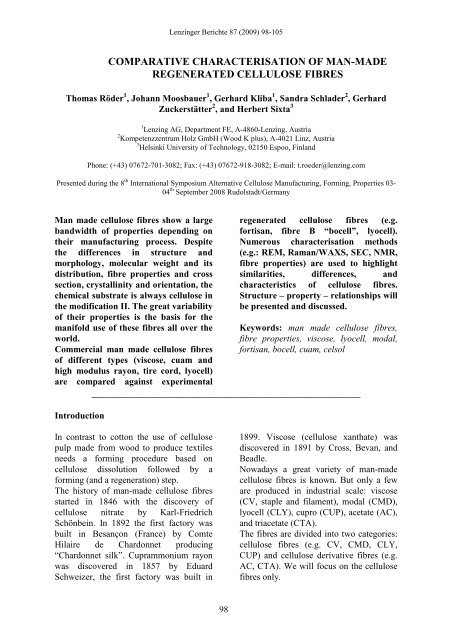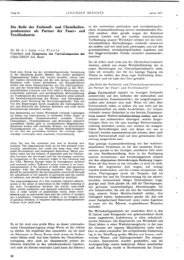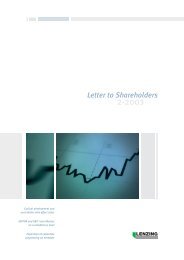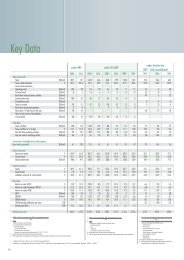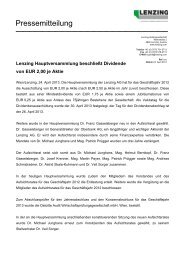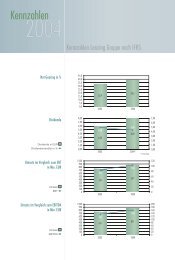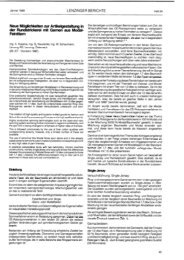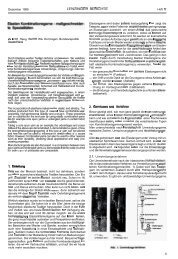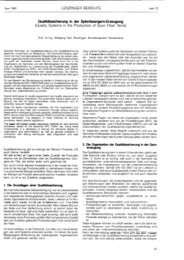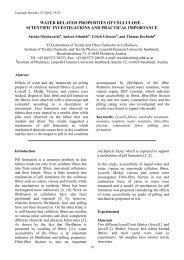comparative characterisation of man-made regenerated ... - Lenzing
comparative characterisation of man-made regenerated ... - Lenzing
comparative characterisation of man-made regenerated ... - Lenzing
You also want an ePaper? Increase the reach of your titles
YUMPU automatically turns print PDFs into web optimized ePapers that Google loves.
<strong>Lenzing</strong>er Berichte 87 (2009) 98-105<br />
COMPARATIVE CHARACTERISATION OF MAN-MADE<br />
REGENERATED CELLULOSE FIBRES<br />
Thomas Röder 1 , Johann Moosbauer 1 , Gerhard Kliba 1 , Sandra Schlader 2 , Gerhard<br />
Zuckerstätter 2 , and Herbert Sixta 3<br />
1 <strong>Lenzing</strong> AG, Department FE, A-4860-<strong>Lenzing</strong>, Austria<br />
2 Kompetenzzentrum Holz GmbH (Wood K plus), A-4021 Linz, Austria<br />
3 Helsinki University <strong>of</strong> Technology, 02150 Espoo, Finland<br />
Phone: (+43) 07672-701-3082; Fax: (+43) 07672-918-3082; E-mail: t.roeder@lenzing.com<br />
Presented during the 8 th International Symposium Alternative Cellulose Manufacturing, Forming, Properties 03-<br />
04 th September 2008 Rudolstadt/Ger<strong>man</strong>y<br />
Man <strong>made</strong> cellulose fibres show a large<br />
bandwidth <strong>of</strong> properties depending on<br />
their <strong>man</strong>ufacturing process. Despite<br />
the differences in structure and<br />
morphology, molecular weight and its<br />
distribution, fibre properties and cross<br />
section, crystallinity and orientation, the<br />
chemical substrate is always cellulose in<br />
the modification II. The great variability<br />
<strong>of</strong> their properties is the basis for the<br />
<strong>man</strong>ifold use <strong>of</strong> these fibres all over the<br />
world.<br />
Commercial <strong>man</strong> <strong>made</strong> cellulose fibres<br />
<strong>of</strong> different types (viscose, cuam and<br />
high modulus rayon, tire cord, lyocell)<br />
are compared against experimental<br />
Introduction<br />
98<br />
<strong>regenerated</strong> cellulose fibres (e.g.<br />
fortisan, fibre B “bocell”, lyocell).<br />
Numerous <strong>characterisation</strong> methods<br />
(e.g.: REM, Ra<strong>man</strong>/WAXS, SEC, NMR,<br />
fibre properties) are used to highlight<br />
similarities, differences, and<br />
characteristics <strong>of</strong> cellulose fibres.<br />
Structure – property – relationships will<br />
be presented and discussed.<br />
Keywords: <strong>man</strong> <strong>made</strong> cellulose fibres,<br />
fibre properties, viscose, lyocell, modal,<br />
fortisan, bocell, cuam, celsol<br />
__________________________________________________<br />
In contrast to cotton the use <strong>of</strong> cellulose<br />
pulp <strong>made</strong> from wood to produce textiles<br />
needs a forming procedure based on<br />
cellulose dissolution followed by a<br />
forming (and a regeneration) step.<br />
The history <strong>of</strong> <strong>man</strong>-<strong>made</strong> cellulose fibres<br />
started in 1846 with the discovery <strong>of</strong><br />
cellulose nitrate by Karl-Friedrich<br />
Schönbein. In 1892 the first factory was<br />
built in Besançon (France) by Comte<br />
Hilaire de Chardonnet producing<br />
“Chardonnet silk”. Cuprammonium rayon<br />
was discovered in 1857 by Eduard<br />
Schweizer, the first factory was built in<br />
1899. Viscose (cellulose xanthate) was<br />
discovered in 1891 by Cross, Bevan, and<br />
Beadle.<br />
Nowadays a great variety <strong>of</strong> <strong>man</strong>-<strong>made</strong><br />
cellulose fibres is known. But only a few<br />
are produced in industrial scale: viscose<br />
(CV, staple and filament), modal (CMD),<br />
lyocell (CLY), cupro (CUP), acetate (AC),<br />
and triacetate (CTA).<br />
The fibres are divided into two categories:<br />
cellulose fibres (e.g. CV, CMD, CLY,<br />
CUP) and cellulose derivative fibres (e.g.<br />
AC, CTA). We will focus on the cellulose<br />
fibres only.
Cellulose fibres can be produced via<br />
cellulose derivatisation followed by<br />
regeneration (involving the destruction <strong>of</strong><br />
the derivative, e.g. viscose) or via<br />
dissolution in a non-derivatising solvent<br />
(e.g. NMMO, Cuoxam, ionic liquids) and<br />
consequent regeneration.<br />
Fibre samples<br />
In this study various commercial fibres are<br />
compared with a great variety <strong>of</strong><br />
experimental fibres. Commercial fibres are<br />
viscose fibres (viscose, tire cord viscose,<br />
polynosic fibres), modal fibres, cupo fibres<br />
(Asahi Kasai), and lyocell fibres (Tencel ® ).<br />
Fibres based on cellulose derivatives are<br />
Fortisan® fibres:<br />
A saponified cellulose acetate prepared by<br />
dry spinning a solution <strong>of</strong> cellulose acetate<br />
in acetone (Celanese Corp., sample kindly<br />
provided by Pr<strong>of</strong>. H. Chanzy, Grenoble,<br />
France). Fibres are highly oriented. The<br />
yarn is no longer produced.<br />
“Fibre B” (Bocell):<br />
Anisotropic solutions <strong>of</strong> cellulose in<br />
superphosphoric acid spun via air-gap into<br />
acetone and saponification in water/soda.<br />
Fibres have high tenacities and are highly<br />
oriented (developed by H. Boerstoel (Akzo<br />
Nobel), sample kindly provided by Dr. S.<br />
Eichhorn, Manchester, UK).<br />
Viscose fibres:<br />
Cellulose xathogenate dissolved in sodium<br />
hydroxide and spun via wet spinning<br />
process into sulphuric acid/ sodium<br />
sulphate/ zinc sulphate. Modal fibres are<br />
produced by a modified viscose process.<br />
Celsol fibres:<br />
Cellulose is dissolved in sodium hydroxide<br />
and <strong>regenerated</strong> in water (Institute <strong>of</strong><br />
Chemical Fibres, Lodz, Poland).<br />
Fibres based on direct dissolved cellulose<br />
are<br />
Cupro fibres:<br />
Cellulose dissolved in tetraaminecopper<br />
dihydroxide (complexation) and<br />
<strong>Lenzing</strong>er Berichte 87 (2009) 98-105<br />
99<br />
<strong>regenerated</strong> in water (Asahi Kasai).<br />
Lyocell fibres:<br />
Cellulose is directly dissolved in<br />
NMMO/water (Tencel®) or ionic liquids<br />
and spun through an air gap and<br />
precipitated in water.<br />
Cellulose solvents, resulting fibre types<br />
and their <strong>characterisation</strong><br />
The cross section is a structural parameter<br />
<strong>of</strong> the fibre which is accessible via<br />
microscopy. Fibre diameters around 10<br />
microns allow the use <strong>of</strong> light microscopy<br />
as well as scanning electron microscopy.<br />
Independent <strong>of</strong> the used solvent system for<br />
cellulose similar cross sections can be<br />
<strong>made</strong> (Figure 1) assuming the use <strong>of</strong><br />
similar spinnerets. However, the same<br />
solvent system but a modified spinning<br />
bath leads to different cross sections<br />
(Figure 2). For viscose the acid<br />
concentration (same dope, same machine,<br />
all the other parameters are the same)<br />
influence the regeneration <strong>of</strong> the cellulose<br />
xanthate. A lower acid content leads to a<br />
“s<strong>of</strong>ter” regeneration. However, high acid<br />
content results in a massive loss <strong>of</strong> degree<br />
<strong>of</strong> polymerization (DP).<br />
The commercially available viscose type<br />
fibres CV, CV tire cord, CMD, and<br />
polynosic (Figure 3) differ in DP <strong>of</strong><br />
cellulose (source), spinning process, and<br />
after treatment. Their fibre properties vary<br />
over a wide range. Nevertheless, further<br />
diversification needs the use <strong>of</strong> other<br />
solvent systems. Higher tenacity, e.g., is<br />
available by using the lyocell process.<br />
Crystallinity increases, too. The solvent for<br />
the commercial Lyocell process is<br />
NMMNO (Tencel®). Similar to Lyocell,<br />
BISFA defines a cellulose fibre obtained<br />
by a spinning process from an organic<br />
solvent mixed with water."Solventspinning"<br />
means dissolution and spinning without<br />
derivatization. Therefore, every spinning<br />
process using ionic liquids to dissolve and<br />
to spin cellulose is a Lyocell process.
Examples for these are given in Figures 1<br />
and 4. The shape and the overall properties<br />
<strong>of</strong> these fibres are comparable to Tencel®<br />
fibres.<br />
The use <strong>of</strong> special pulp sources (e.g. cotton<br />
linters pulp) and special spinning<br />
conditions allows the <strong>man</strong>ufacturing <strong>of</strong><br />
fibres with higher tenacity and higher<br />
modulus. However, the fibre properties are<br />
in the same range as for NMMO fibres,<br />
which could be improved by the named<br />
changes in pulp source and spinning<br />
conditions, too.<br />
NMMO and ionic liquids are the most<br />
recent cellulose solvents used and lie in the<br />
focus <strong>of</strong> actual research. Other solvents for<br />
cellulose like hydrates <strong>of</strong> inorganic salts,<br />
e.g., zinc chloride and lithium perchlorate;<br />
lithium chloride and dimethylacetamide<br />
(DMAc); and metal complex solvents, e.g.,<br />
copper ethylendiamine (Cu-en), are known<br />
and some are used for analytical purpose<br />
(LiCl-DMAc for SEC; Cu-en for intrinsic<br />
viscosity measurement), but they are not<br />
<strong>Lenzing</strong>er Berichte 87 (2009) 98-105<br />
100<br />
used to make fibres.<br />
Another interesting approach is the<br />
CELSOL concept: Cellulose is dissolved<br />
in sodium hydroxide. Known from the<br />
viscose process, where cellulose reacts<br />
with sodium hydroxide to sodium<br />
cellulose, sodium hydroxide is able to<br />
dissolve hemicellulose and shorter<br />
cellulose molecules. The idea is to use<br />
sodium hydroxide directly without<br />
cellulose xanthate as for viscose to<br />
produce <strong>man</strong> <strong>made</strong> fibres. The<br />
disadvantage is in the limited solubility <strong>of</strong><br />
longer cellulose chains. Therefore,<br />
presumably only fibres lower than viscose<br />
quality will be possible.<br />
During World War 2 a process for<br />
<strong>man</strong>ufacturing <strong>of</strong> cellulose silk for<br />
parachutes was developed: Fortisan®<br />
(Figure 4). These fibres have a high<br />
crystallinity, high orientation, and high<br />
modulus. Therefore they are very lean and<br />
thin. Fortisan® was produced via a dry<br />
spinning process.<br />
Figure 1. SEM figures <strong>of</strong> <strong>regenerated</strong> cellulose fibres with round shape.<br />
Figure 2. Influence <strong>of</strong> acid content in spinbath for viscose types <strong>of</strong> fibres.
<strong>Lenzing</strong>er Berichte 87 (2009) 98-105<br />
Figure 3. SEM figures <strong>of</strong> different viscose types <strong>of</strong> fibres.<br />
Figure 4. SEM figures <strong>of</strong> <strong>regenerated</strong> cellulose fibres with different cross sections.<br />
Table 1. Fibre data.<br />
Tenacity Elongation Tenacity Elongation BISFA modulus Commercial/<br />
titre cond. cond. wet wet modulus cond. experimental<br />
[dtex] [cN/dtex] [%] [cN/dtex] [%] [cN/tex/5%] [cN/tex/%] fibre<br />
Tencel® 1,3 40,2 13,0 37,5 18,4 10,8 8,8 com.<br />
polynosic 1,8 38,2 9,7 26,0 11,0 12,1 n.a. com.<br />
cupro 2,5 22,3 24,3 17,6 51,3 5,0 9,9 com.<br />
EMIM-Cl 1,7 43,0 9,6 35,9 11,6 14,0 8,1 exp.<br />
BMIM-Cl 1,5 50,1 9,3 39,4 10,4 17,8 n.a. exp.<br />
CV 1,4 23,9 20,1 12,5 22,0 2,4 5,3 com.<br />
CV tire cord 1,9 52,3 15,1 38,4 22,9 3,1 11,1 com.<br />
CMD 1,3 33,1 13,5 18,4 14,1 5,2 6,3 com.<br />
fibre B 1,6 89,4 6,8 75,8 7,9 39,0 23,5 exp.<br />
EMIM-Ac 1,8 44,7 10,4 38,1 11,9 13,2 10,0 exp.<br />
Fortisan® 0,7 23,9 3,2 27,7 5,1 27,0 n. a. exp.<br />
Celsol 3,32 16,96 7,8 7,2 11,2 4 n. a. exp.<br />
Up to now the highest crystallinity,<br />
orientation, and tenacity is known from the<br />
so-called “fibre B”. This experimental<br />
fibre is produced from liquid crystalline<br />
solution <strong>of</strong> cellulose in superphosphoric<br />
acid and spun into acetone followed by<br />
saponification. This has similarities to the<br />
old Fortisan® process where cellulose<br />
101<br />
acetate is spun into acetone, too.<br />
In contrast to viscose type fibres (wet<br />
spinning) all these fibres are produced via<br />
air-gap in a dry-wet (Lyocell) or in a dry<br />
spinning process (followed by<br />
saponification: Fortisan®, fibre B).<br />
Characteristic fibre data are given in Table<br />
1.
Structural parameters and fibre properties<br />
Fibre properties can be varied within a<br />
wide range by using the same dope and the<br />
same spinning process. The level <strong>of</strong><br />
stretching determines the tenacity and<br />
elongation level. A high degree <strong>of</strong><br />
stretching results in a relatively tearresistant<br />
and low-strain fibre.<br />
The product <strong>of</strong> tenacity and elongation is<br />
called “working capacity”. This “working<br />
capacity” is mainly determined by the<br />
process and the solvent used. The<br />
molecular weight <strong>of</strong> the cellulose should<br />
be in an optimum range for the used<br />
solvent. The length <strong>of</strong> cellulose chains<br />
should be high enough to be able to form<br />
fibres. Cellulose chains should, however,<br />
not be too long, since this would increase<br />
the viscosity <strong>of</strong> the dope too much. For<br />
every <strong>man</strong>ufacturing process there exists a<br />
different optimum range. Structural<br />
parameters like orientation are mainly<br />
influenced by the stretching during fibre<br />
making. The liquid crystalline structure <strong>of</strong><br />
the dope for “fibre B” is one reason for the<br />
high crystallinity <strong>of</strong> the fibres. The<br />
structure <strong>of</strong> the cellulose inside the dope,<br />
the width <strong>of</strong> cellulose molecular weight<br />
distribution, and the velocity <strong>of</strong><br />
regeneration process mainly determine the<br />
crystallinity <strong>of</strong> the fibres. WAXS (wide<br />
angle X-ray scattering) is the standard<br />
method for the determination <strong>of</strong><br />
crystallinity <strong>of</strong> <strong>man</strong>-<strong>made</strong> cellulose fibres<br />
(Her<strong>man</strong>s and Weidinger 1949) [1].<br />
The information concerning crystallinity <strong>of</strong><br />
cellulose II can be obtained by other<br />
methods as well, e.g. Fourier Transform<br />
(FT) Ra<strong>man</strong>, FT-infrared (IR), or solid<br />
state<br />
13 C NMR (nuclear magnetic<br />
resonance) spectroscopy. Ra<strong>man</strong> and IR<br />
based methods normally use a calibration<br />
with WAXS data [2] [3]. Therefore these<br />
methods can only be as good as the<br />
reference method itself.<br />
One <strong>of</strong> the factors determining the<br />
properties <strong>of</strong> cellulose fibres is the<br />
<strong>Lenzing</strong>er Berichte 87 (2009) 98-105<br />
102<br />
Tenacity cond [cN/tex]<br />
50<br />
40<br />
30<br />
CLY, same dope, different draft<br />
20<br />
0,10 0,15 0,20 0,25 0,30 0,35<br />
f 2<br />
C(WAXS) *X IR<br />
Figure 5. CLY fibre <strong>man</strong>ufacturing with the same<br />
dope at various draft levels – correlation <strong>of</strong> tenacity<br />
and structural parameters orientation and<br />
crystallinity.<br />
Figure 6. WAXS versus FT-Ra<strong>man</strong> crystallinity<br />
[2].<br />
alignment <strong>of</strong> the fibrillar elements relative<br />
to the fibre axis. A relationship between<br />
the degree <strong>of</strong> orientation and the tensile<br />
strength <strong>of</strong> viscose fibres was put forth by<br />
Krässig and Kitchen [4]:<br />
Strength or tenacity in the conditioned<br />
state<br />
FFc ~ f 2 c<br />
and strength or tenacity in the wet state.<br />
FFn ~ f 2,5 tot<br />
The classical method to quantify<br />
orientation <strong>of</strong> polymer fibres is wide angle<br />
X-ray scattering (WAXS). The WAXS<br />
results were compared with Ra<strong>man</strong> results<br />
to obtain a Ra<strong>man</strong>-based method to<br />
determine the degree <strong>of</strong> orientation <strong>of</strong><br />
cellulose II (Figure 7 and 8).
<strong>Lenzing</strong>er Berichte 87 (2009) 98-105<br />
Figure 7. Calibration <strong>of</strong> crystalline fibre orientation - WAXS versus Ra<strong>man</strong>.<br />
Figure 8. Calibration <strong>of</strong> total fibre orientation – WAXS versus Ra<strong>man</strong>.<br />
The higher resolution <strong>of</strong> Ra<strong>man</strong><br />
spectroscopy can be used as a tool for<br />
determining the local fibres orientation.<br />
Another common method to measure the<br />
fibre orientation is the birefringence. A<br />
microscope equipped with polarisers and a<br />
compensator is used. The birefringence n<br />
is obtained by dividing the measured<br />
retardation <strong>of</strong> polarised light by the<br />
respective fibre thickness. By relating n<br />
to the maximum birefringence <strong>of</strong> cellulose<br />
nmax, the orientation factor f (Her<strong>man</strong>s’<br />
orientation factor) can be calculated<br />
according to f = n/nmax. Factor f = 1<br />
means perfect orientation parallel to the<br />
103<br />
fibre direction, f = 0 for random<br />
orientation, and -1 for perfect transverse<br />
orientation. This method is very useful for<br />
fibres with a round cross section, e.g.<br />
lyocell, and no crimp and distortion.<br />
Unfortunately, most <strong>of</strong> commercial fibres<br />
have no round cross section, are crimped,<br />
or both. This results in large differences <strong>of</strong><br />
orientation values.<br />
According to Krässig and Kitchen [4] a<br />
linear correlation between the degree <strong>of</strong><br />
orientation and the fibre tenacity in<br />
conditioned as well as in wet state was<br />
found. Especially a series <strong>of</strong> CLY <strong>made</strong><br />
from the same dope spun under different<br />
drafts showed a very good correlation
(Figure 5). The comparison <strong>of</strong> different<br />
<strong>man</strong>-<strong>made</strong> cellulose fibres used for<br />
analytical method development is given in<br />
Figures 9 and 10. Despite the CV tire cord<br />
the fibres showed more or less a linear<br />
correlation between tenacity and fibre<br />
orientation.<br />
Tenacity cond [cN/tex]<br />
60<br />
50<br />
40<br />
30<br />
20<br />
10<br />
f C ...degree <strong>of</strong> orientation <strong>of</strong> crystalline regions<br />
X IR ...crystallinity determined by infrared spectroscopy<br />
0<br />
0,0 0,1 0,2<br />
f<br />
0,3<br />
2<br />
C(WAXS) *XIR <strong>Lenzing</strong>er Berichte 87 (2009) 98-105<br />
CLY<br />
CMD<br />
Polynosic<br />
CV<br />
Cupro<br />
CV tire cord<br />
Figure 9. Correlation between tenacity<br />
(conditioned state) and structural parameters –<br />
crystalline fibre orientation and crystallinity.<br />
Tenacity wet [cN/tex]<br />
45<br />
40<br />
35<br />
30<br />
25<br />
20<br />
CLY<br />
15<br />
CMD<br />
Polyosic<br />
10<br />
CV<br />
5<br />
0<br />
Cupro<br />
CV tire cord<br />
0,00 0,05 0,10 0,15<br />
f 2.5<br />
tot(WAXS) *XIR Figure 10. Correlation between tenacity (wet state)<br />
and structural parameters – total fibre orientation<br />
and crystallinity.<br />
As mentioned above, the molecular weight<br />
distribution is another important<br />
parameter. State <strong>of</strong> the art is the<br />
determination <strong>of</strong> the molecular weight<br />
distribution by size exclusion<br />
chromatography (SEC). Essential is the<br />
choice <strong>of</strong> a suitable solvent system, e.g.<br />
LiCl-DMAc. Another possibility is the use<br />
<strong>of</strong> cellulose derivatives, e.g. cellulose<br />
nitrate. In this study SEC based on LiCl-<br />
DMAc was used (Figure 11).<br />
104<br />
differential molecular weight<br />
differential molecular weight<br />
1,5<br />
1,2<br />
0,9<br />
0,6<br />
0,3<br />
0,0<br />
1,5<br />
1,2<br />
0,9<br />
0,6<br />
0,3<br />
0,0<br />
fortisan<br />
fibre "B" bocell<br />
CV tire cord<br />
3,5 4,0 4,5 5,0 5,5 6,0<br />
log molar mass<br />
CV<br />
polynosic<br />
celsol<br />
3,5 4,0 4,5 5,0 5,5 6,0<br />
log molar mass<br />
Figure 11. Comparison <strong>of</strong> molecular weight<br />
distribution <strong>of</strong> <strong>man</strong>-<strong>made</strong> cellulose fibres.<br />
Lyocell fibres (Tencel® and ionic liquid<br />
fibres) have a higher molecular weight<br />
than viscose fibres. The spectrum depends<br />
on the used pulp. While the cellulose is<br />
degraded in the ripening step in the viscose<br />
process, the degradation during the lyocell<br />
process is prevented by added stabilizers.<br />
Therefore, the molecular weight <strong>of</strong> lyocell<br />
fibres is mainly determined by the used<br />
pulp. Normally, the degradation during the<br />
lyocell process should be less than 10%.<br />
The elastic modulus (Young’s modulus) is<br />
the linear slope <strong>of</strong> stress (tenacity) versus<br />
strain (elongation). It is a measure <strong>of</strong> the<br />
stiffness <strong>of</strong> a material. A higher elastic<br />
modulus means a higher resistance <strong>of</strong> the<br />
fibre against deformation. A comparison <strong>of</strong><br />
typical stress-strain-curves is given in<br />
Figures 12 and 13. The highest value for<br />
the elastic modulus and tenacity as well<br />
was reached by fibre “B” (bocell). The<br />
lowest value was determined for viscose<br />
fibres. To get fibres in between these two<br />
values, the solvent and/or the
<strong>man</strong>ufacturing process has to be chosen<br />
carefully.<br />
tenacity cond [cN/tex]<br />
Figure 12. Stress-strain curve <strong>of</strong> viscose type <strong>man</strong><br />
<strong>made</strong> fibres.<br />
tenacity [cN/tex]<br />
40 CV tire cord<br />
CMD<br />
CV<br />
30<br />
20<br />
10<br />
0<br />
0 2 4 6 8 10 12 14 16 18 20<br />
50<br />
40<br />
30<br />
20<br />
10<br />
0<br />
0 5 10 15 20<br />
elongation [%]<br />
<strong>Lenzing</strong>er Berichte 87 (2009) 98-105<br />
Tencel<br />
Fortisan<br />
Fibre B<br />
Figure 13. Stress-strain curve <strong>of</strong> high modulus fibres<br />
compared with Tencel®.<br />
Conclusions<br />
elongation cond [%]<br />
Man-<strong>made</strong> cellulose fibres are <strong>man</strong>ifold<br />
and open a fascinating field <strong>of</strong> research<br />
and application. The further development<br />
<strong>of</strong> these fibres will surely direct to some<br />
surprising properties and facts. After more<br />
than 100 years <strong>of</strong> viscose fibres, even there<br />
the development is not completed.<br />
105<br />
Acknowledgements<br />
The authors thank Dr. Hans-Peter Fink and<br />
Dr. Andreas Bohn (IAP Golm, Ger<strong>man</strong>y)<br />
for the WAXS measurements concerning<br />
crystallinity, Pr<strong>of</strong>. Dr. Peter Zipper and Dr.<br />
Boril Cernev (University <strong>of</strong> Graz, Austria)<br />
for the WAXS measurements concerning<br />
orientation, and Anneliese Flachberger<br />
(<strong>Lenzing</strong> AG, Austria) for the textile<br />
measurements.<br />
We would like to thank Pr<strong>of</strong>. Dr. Henry<br />
Chancy (Grenoble, France) for the kind<br />
donation <strong>of</strong> the Fortisan fibre, Dr. Frank<br />
Dürsen (Obernburg, Ger<strong>man</strong>y) for the<br />
viscose tire cord fibres, Dr. Birgit Kosan<br />
(TITK Rudolstadt, Ger<strong>man</strong>y) for the ionic<br />
liquid fibres, and Dr. Stephen J. Eichhorn<br />
(University <strong>of</strong> Manchester, UK) for the<br />
fibre “B” (bocell).<br />
References<br />
[1] P. H. Her<strong>man</strong>s and A. Weidinger. Xray<br />
studies on the crystallinity <strong>of</strong><br />
cellulose, J. Polymer Sci. 4 (1949) 135-<br />
144.<br />
[2] T. Röder, J. Moosbauer, M. Fasching,<br />
A. Bohn, H.-P. Fink, T. Baldinger, and<br />
H. Sixta. Crystallinity determination <strong>of</strong><br />
native cellulose -comparison <strong>of</strong><br />
analytical methods, <strong>Lenzing</strong>er Berichte<br />
86 (2006), 85-89.<br />
[3] T. Baldinger, J. Moosbauer, and H.<br />
Sixta. Supermolecular structure <strong>of</strong><br />
cellulosic materials by Fourier<br />
Transform Infrared Spectroscopy (FT-<br />
IR) calibrated by WAXS and 13 C<br />
NMR, <strong>Lenzing</strong> Berichte, 79 (2000) 15<br />
- 17.<br />
[4] H. Krässig and W. Kitchen. Factors<br />
influencing tensile properties <strong>of</strong><br />
cellulose fibres, J. Polymer Sci. 51<br />
(1961) 123-172.


